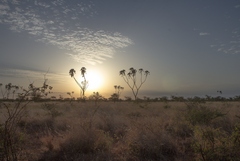
Dawn breaks over the semi arid Meru
National Park. The distinctive shapes of
doum palms dot the skyline
Meru is located in East Central Kenya to the North East of Mt Kenya and East of the Nyambene hills, which are vital for the all year round supply of water to the Park. Meru was where Elsa the lion, of Born Free fame, was raised by George and Joy Adamson. Elsa's grave is in the Park.
Its elevation is about 1000m in the Northwest dropping to 300m around the Tana river and its topography is generally fairly flat or slightly undulating.
One of the more noticeable aspects of the Park is the predominantly red lateritic soil. Dust from the soil tends to turn everything reddish brown.
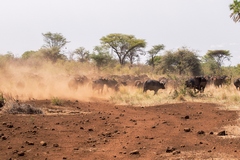
The dry reddish soil - stained by iron oxide,
and known as laterite, covers everything in a
fine dust. Laterites develop in tropical areas
by weathering of the underlying parent rock
Its area is 870km2, although the Bisanadi Reserve is contiguous to the Northeast and adds another 606km2. Also the Mwingi reserve is located to the Southwest and adds another 745km2. The latter two reserves act as buffer zones and as dispersal areas for game in the dry season. Together the three areas form a large ecosystem with the Tana river at the Southern border. On the other side of the river the Park links with the Kora National Reserve, which is another 1788km2 and then onto Rahole National Reserve in the East. Excluding Rahole the other four areas form the 4400km2 Meru Conservation area.
Safaris are generally carried out in Meru and Bisanadi as Mwingi is a designated wilderness area.
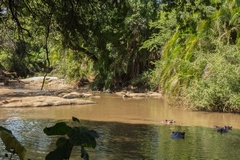
The largest of the rivers flowing through the
Park is the Rojowero. As well as a good head
of fish it is home to many hippos, crocodiles
and terrapins
One of the great assets of Meru National Park is the all year round availability of water. There are 13 permanent rivers within the park. Not all big, but vital sources of water in this hot dry area. The biggest river is the Rojowero. Others include the Murera, the Mutundu and the Bwatherongi. When traversing the park it entails frequent crossings of these small shallow rivers.
Meru is classed as a semi arid zone. Rain, when it does rain, is generally in November and December, and Longer heavier rain falls from April to June. Amounts of rainfall vary considerably but average out at 635-762mm to the West, nearest the hills, and 305-356 mm in the East. Meru is a hot area. In Winter time the Night time temperatures don't drop very low and sweaters aren't needed at all, even first thing in a morning when setting off in the safari vehicle. During the day in June Temperatures easily rise to around 30 Degrees C and it is very pleasant.
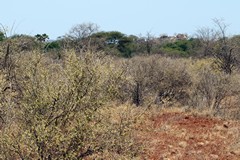
In some parts of the Park there are large
areas of croton thickets. These can make
game spotting more difficult especially in the
wetter months before the leaves drop
Vegetation is very varied. There are large areas of open or wooded grassland, and the grass can get very long. In the wetter months long grass and the greening croton thickets can make it more difficult to spot game. However in June/July the grass is golden yellow and dying back and a lot of the bush has shed its leaves and so game spotting is relatively easy.
There are big areas of thick bush of various types, with a lot of acacias and commiphora woodland. Along the rivers are narrow bands of thick woodland with lush green undergrowth, which are always good places for the resident wildlife to hide in. Doum palms are conspicuous all along the skyline. There lots of figs and occasional baobabs.
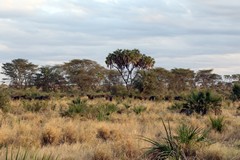
Thin bands of woodland follow the course of
the streams and rivers
There are swamps in the Northern part of the park including the Bwatherongi and Mururi swamps. Many are permanent and attract large herds of buffalos and elephants, especially in the dry season.
Tsetse flies are present. There is an ongoing campaign to eradicate them from the Park, and they were rarely seen (or felt) when we visited the Park in late June.
Meru as a Game Park is absolutely top dollar. I've been all over Kenya and Tanzania and I'd put Meru as equal 2nd (Ruaha in Tanzania takes the Crown). There's tons of wildlife and very little traffic at present.
The background to this is that years ago Meru was Kenya's premier Park. But then the management let it down and poachers moved in and basically emptied it in the late 1980s and early 90's. Finally it was resurrected by Kenya Wildlife Service from 2000 to 2005 and money totalling $1.25million was donated from the International Fund for Animal Welfare (IFAW) to help and ensure that there was adequate protection from poachers. The work is ongoing but the wildlife has bounced back.
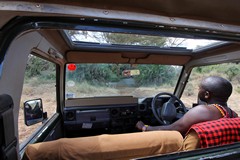
You will ford the rivers lots of times during a day's
safari. The crossing points are good places
to photograph many species of birds
The big herds of buffalos encourage lions to live in the Park, although numbers of lions are still low and a 2015 survey suggested there are about eighty.
There are more common waterbuck than anywhere I've been in Kenya or Tanzania. There are all the usuals you'd expect to see including zebras, hartebeeste, impalas, Grant's gazelles etc. and the bigger rivers have families of hippos and crocodiles in them.
There are a number of rare species and several that are unique to the area North of the Tana river. These include reticulated giraffes, beisa oryx, Somali ostrich, gerenuks, and even a very few reintroduced Grevy's zebras. Together these species are known as 'The Northern Five'. Lesser kudus also abound in the park. We were lucky enough to see a striped hyaena one night and there was a leopard in residence very close to our camp.
Birdlife is excellent with over 427 types being recorded.
I have to say the elephants in Meru were pretty good; we got seriously close to one or two and they were all very relaxed, which may be a sign of good protection from poachers. Quite a few of them had decent ivory - which makes a change from those in Tanzania where they are being wiped out on an industrial scale.
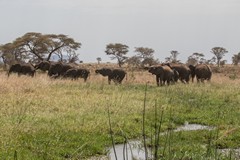
Here an elephant family enjoy a drink in one
of the fast flowing clear streams that cross the
Park. The availabilty of water all year round
encourages them not to migrate in the dry
season
Finally there is a large 40km2 (and being made even larger by the addition of another 29km2) rhino sanctuary with both black and white rhinos in it. The white rhinos, at least, are easy to see as they favour the more open ground. The blacks of course hide in the thick bush so spotting them is a matter of good luck. The rhinos are well protected by the rangers and are breeding, hence the need for more space.
Tourist traffic is very low. On most drives we saw nobody except the odd car on the main arterial road through the park.
Threats to the park are from human wildlife conflict, and poaching for bushmeat mostly by the indiscriminate use of wire snares. It is also becomming increasingly apparent that more and more water is being used for farming locally, and some of the rivers in the park are now starting to dry up for part of the year. This will have a bad effect on animals that are very water dependant such as buffalos and elephants.
My advice is that if you are going to safari in Kenya you should definately include Meru, and go before it gets too popular.
Watch the Meru in June video.